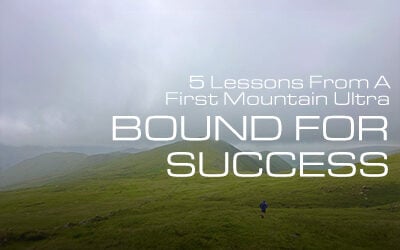What’s it like Fastpacking 80mi along the length of the (not so) Misty Isle on the Skye Trail? Bog dodging & midge wrangling galore!
Fell & Ultra Runner Emily Cartigny explores what it was that Shania Twain was singing about* and how it applies to the wonderful world of fell and ultra running.
In many ways, the world of running can feel like a man’s world. Particularly in longer distances and off-road events, standing on the start line can feel like you’re the only woman there. So, on International Women’s Day, what better way to commemorate the day than celebrating the uniquely female experience of running in the mountains?
Stubbornness Is Your Greatest Strength
Stubborn is a word that has often been used to describe me as a child. That was probably the polite term (others might include moody or stroppy). The word was often used negatively – something I needed to grow out of. But, in fact, I grew into it. That stubbornness, turned into fierce determination to never give up when things get tough. A trait it would be impossible to complete an ultra-marathon without.
Strong Takes You Further Than Skinny
Within sport, particularly endurance sports, there is often the belief that lighter bodies are better for performance. I’ve fallen into this trap of under fuelling in the hope of being lighter more times than I’d care to admit. However, the simple reality is that we cannot ask our bodies to run for miles if it’s not sufficiently fuelled.
Eventually, I decided to face the question of which is more important to me: A body that takes up less space or a body that is strong enough to get me to the finish line? I decided to choose a stronger body and focused on learning to love what it can do. With that came a new sense of contentment, confidence, and performance.
Embrace Your Pace
Since, as women, we are in the minority within this sport, you often find yourself training with men. For me, it’s my husband. After the first few steps of a run, I’ll typically spend the rest of the time looking at the back of his head. I used to huff away to myself behind him, proclaiming how unfair it was that he was faster.
It wasn’t until we started spending full days out on the fells that the tables turned. After plodding along for 6-7 hours, I started to notice it was me now looking behind for my other half. He may have a greater top speed, but my slow and steady pacing would win out eventually. The real-life version of the hare and the tortoise.
There Is Power in Understanding Your Period
When it comes to your menstrual cycle, despite what we might have previously been told, the good news is there’s no evidence to suggest that performance is affected by your hormones. But it only takes one conversation with most women to know hormones can affect motivation, competitiveness, mood, and fatigue. For ultra-runners, when the challenge is as much psychological as it is physical, this could easily be the difference between crossing the finish line and a DNF.
Adapting your training to your cycle is underpinned by your knowledge of yourself. Through tracking my cycle on an app, I could start tuning into how I was feeling on specific days and noticing any differences. From there I could adapt my training to maximise when I was feeling good and rest when my body was calling for it. For me, there are the same few days in my cycle where I am the most determined, stubborn, and powerful. So, I used that oestrogen-fuelled-super-women feeling to load up on my training.
You’ll Never Know How Far You Can Go Until You Try
There are four words every runner will inevitably say to themselves: “I can’t do this”. I’ve said it to myself before even stepping out the door. The self-doubt creeps in and makes you want to play it safe. Anyone will feel like this at some point, but I think as women we’re often encouraged to be careful rather than be brave.
Some days the self-doubt might be right. It’s not the right day or you’ve attempted to jump up the mileage too quickly. But those days are not the important days. From experience, I know I’d rather take a DNF (Did Not Finish) than the unanswered question of “what if”. Because most of the time, once you get your head down and take one step at a time, you’ll surprise yourself at how far you can go.
Thanks to Emily Cartigny & Tom McNally for the images
*For those unfamiliar with the 1997 classic: “Man, I Feel Like A Woman”
Fell & Ultra Runner Emily Cartigny explores what it was that Shania Twain was singing about* and how it applies to the wonderful world of fell and ultra running.
In many ways, the world of running can feel like a man’s world. Particularly in longer distances and off-road events, standing on the start line can feel like you’re the only woman there. So, on International Women’s Day, what better way to commemorate the day than celebrating the uniquely female experience of running in the mountains?
Stubbornness Is Your Greatest Strength
Stubborn is a word that has often been used to describe me as a child. That was probably the polite term (others might include moody or stroppy). The word was often used negatively – something I needed to grow out of. But, in fact, I grew into it. That stubbornness, turned into fierce determination to never give up when things get tough. A trait it would be impossible to complete an ultra-marathon without.
Strong Takes You Further Than Skinny
Within sport, particularly endurance sports, there is often the belief that lighter bodies are better for performance. I’ve fallen into this trap of under fuelling in the hope of being lighter more times than I’d care to admit. However, the simple reality is that we cannot ask our bodies to run for miles if it’s not sufficiently fuelled.
Eventually, I decided to face the question of which is more important to me: A body that takes up less space or a body that is strong enough to get me to the finish line? I decided to choose a stronger body and focused on learning to love what it can do. With that came a new sense of contentment, confidence, and performance.
Embrace Your Pace
Since, as women, we are in the minority within this sport, you often find yourself training with men. For me, it’s my husband. After the first few steps of a run, I’ll typically spend the rest of the time looking at the back of his head. I used to huff away to myself behind him, proclaiming how unfair it was that he was faster.
It wasn’t until we started spending full days out on the fells that the tables turned. After plodding along for 6-7 hours, I started to notice it was me now looking behind for my other half. He may have a greater top speed, but my slow and steady pacing would win out eventually. The real-life version of the hare and the tortoise.
There Is Power in Understanding Your Period
When it comes to your menstrual cycle, despite what we might have previously been told, the good news is there’s no evidence to suggest that performance is affected by your hormones. But it only takes one conversation with most women to know hormones can affect motivation, competitiveness, mood, and fatigue. For ultra-runners, when the challenge is as much psychological as it is physical, this could easily be the difference between crossing the finish line and a DNF.
Adapting your training to your cycle is underpinned by your knowledge of yourself. Through tracking my cycle on an app, I could start tuning into how I was feeling on specific days and noticing any differences. From there I could adapt my training to maximise when I was feeling good and rest when my body was calling for it. For me, there are the same few days in my cycle where I am the most determined, stubborn, and powerful. So, I used that oestrogen-fuelled-super-women feeling to load up on my training.
You’ll Never Know How Far You Can Go Until You Try
There are four words every runner will inevitably say to themselves: “I can’t do this”. I’ve said it to myself before even stepping out the door. The self-doubt creeps in and makes you want to play it safe. Anyone will feel like this at some point, but I think as women we’re often encouraged to be careful rather than be brave.
Some days the self-doubt might be right. It’s not the right day or you’ve attempted to jump up the mileage too quickly. But those days are not the important days. From experience, I know I’d rather take a DNF (Did Not Finish) than the unanswered question of “what if”. Because most of the time, once you get your head down and take one step at a time, you’ll surprise yourself at how far you can go.
Thanks to Emily Cartigny & Tom McNally for the images
*For those unfamiliar with the 1997 classic: “Man, I Feel Like A Woman”


If you have a story to tell, whether it’s from the OMM, another race or challenge or just how you use our kit, get in touch! Just pop an email to james@team-ark.com and who knows, you might just earn yourself some free kit!
More Like this
Bound For Success
Sports Therapist and Hybrid Athlete, Katie Barber takes the plunge into long-distance mountain running with Beat The Bounds, a 28mi round of Patterdale the perfect introduction to what running a long way in the high fells is all about.
Triumph, Torture & Torta: Trofeo Nasego Classic
Oscar pulls on the England vest for a taste of the dolce vita at the Trofeo Nasego Classic in Italy.








